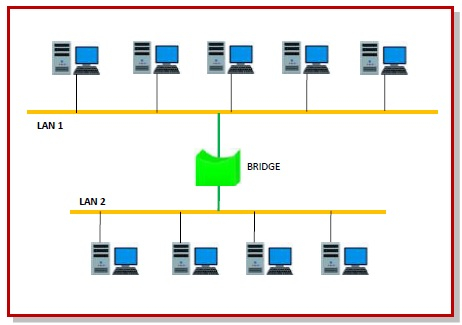
 Data Structure
Data Structure Networking
Networking RDBMS
RDBMS Operating System
Operating System Java
Java MS Excel
MS Excel iOS
iOS HTML
HTML CSS
CSS Android
Android Python
Python C Programming
C Programming C++
C++ C#
C# MongoDB
MongoDB MySQL
MySQL Javascript
Javascript PHP
PHP
- Selected Reading
- UPSC IAS Exams Notes
- Developer's Best Practices
- Questions and Answers
- Effective Resume Writing
- HR Interview Questions
- Computer Glossary
- Who is Who
Uses of Bridges in Computer Network
A bridge is a network device that connects multiple LANs (local area networks) together to form a larger LAN. The process of aggregating networks is called network bridging. A bridge connects the different components so that they appear as parts of a single network. Bridges operate at the data link layer of the OSI model and hence also referred as Layer 2 switches.
The following diagram shows a bridges connecting two LANs −

Uses of Bridge
- Bridges connects two or more different LANs that has a similar protocol and provides communication between the devices (nodes) in them.
- By joining multiple LANs, bridges help in multiplying the network capacity of a single LAN.
- Since they operate at data link layer, they transmit data as data frames. On receiving a data frame, the bridge consults a database to decide whether to pass, transmit or discard the frame.
- If the frame has a destination MAC (media access control) address in the same network, the bridge passes the frame to that node and then discards it.
- If the frame has a destination MAC address in a connected network, it will forward the frame toward it.
- By deciding whether to forward or discard a frame, it prevents a single faulty node from bringing down the entire network.
- In cases where the destination MAC address is not available, bridges can broadcast data frames to each node. To discover new segments, they maintain the MAC address table.
- In order to provide full functional support, bridges ideally need to be transparent. No major hardware, software or architectural changes should be required for their installation.
- Bridges can switch any kind of packets, be it IP packets or AppleTalk packets, from the network layer above. This is because bridges do not examine the payload field of the data frame that arrives, but simply looks at the MAC address for switching.
- Bridges also connect virtual LANs (VLANs) to make a larger VLAN.
- A wireless bridge is used to connect wireless networks or networks having a wireless segment.

Advertisements
